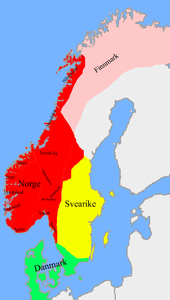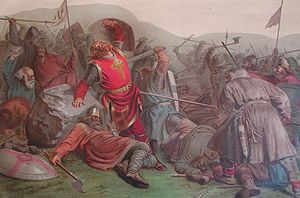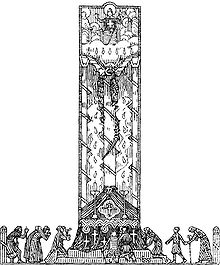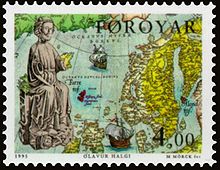- Olaf II of Norway
-
Saint Olaf of Norway 
A medieval representation of Saint Olaf.King and Martyr Born 995 Died July 29, 1030 (aged c. 35) Honored in Roman Catholic Church, Eastern Orthodox Church, Lutheran Church Canonized 1164 by Alexander III Major shrine Trondheim Feast July 29; also August 3 (translation) and October 16 (conversion)[1][2] Attributes crown, axe, dragon Patronage carvers; difficult marriage; kings; Norway, Faroe Islands, Åland Olaf II Haraldsson (995 – July 29, 1030) was King of Norway from 1015 to 1028. He was posthumously given the title Rex Perpetuus Norvegiae (English: Norway's Eternal King) and canonised in Nidaros (Trondheim) by Bishop Grimkell, one year after his death in the Battle of Stiklestad on 29 July 1030. Enshrined in Nidaros Cathedral. Olaf's local canonisation was in 1164 confirmed by Pope Alexander III, making him a universally recognized saint of the Catholic Church. The exact position of Saint Olaf's grave in Nidaros has been unknown since 1568, due to the Lutheran iconoclasm in 1536-37. Saint Olaf has today a prominent legal as well as cultural position in the country. He is symbolised by the axe in Norway's coat of arms, and the Olsok (29th July) is still his day of celebration. The Order of St. Olav is named after him.
Contents
Name
Olaf II's Old Norse name is Ólafr Haraldsson. He was during his lifetime known as Olaf digre (modern orthography). Today, he is commonly referred to as Olav den hellige (Bokmål; Olaf the Holy) or Heilag-Olav (Nynorsk; the Holy Olaf) in honour of his sainthood.[3]
Olaf Haraldsson had the given name Óláfr in Old Norse. (Etymology: Anu – "forefather", Leifr – "heir".) Olav is the modern equivalent in Norwegian, formerly often spelt Olaf. His name in Icelandic is Ólafur, in Faroese Ólavur, in Danish Oluf, in Swedish Olof. Olave was the traditional spelling in England, preserved in the name of medieval churches dedicated to him. Other names, such as Oláfr hinn helgi, Olavus rex, and Olaf are used interchangeably (see the Heimskringla of Snorri Sturluson). He is sometimes referred to as Rex Perpetuus Norvegiae (English: Norway's Eternal King), a designation which goes back to the thirteenth century. The term Ola Nordmann as epithet of the archetypal Norwegian may originate in this tradition, as the name Olav for centuries was the most common male name in Norway.
Background
Olaf was born in Ringerike. His mother was Åsta Gudbrandsdatter, and his father was Harald Grenske, great-great-grandchild of Harald Fairhair, the first king of Norway. Harald Grenske died when Åsta Gudbrandsdatter was pregnant with Olaf. She later married Sigurd Syr, with whom she had other children including Harald Hardrada who would reign as a future king of Norway.
Reign
Olaf was the subject of several biographies, both hagiographies and sagas, in the Middle Ages, and many of the historical facts concerning his reign are disputed. The best known description is the one in Snorri Sturluson's Heimskringla, from c. 1230. That saga cannot be taken as an accurate source for Olaf's life, but most of the following description is based on the narrative there.
About 1008, Olaf landed on Estonian island Saaremaa (Osilia). The Osilians, taken by surprise, had at first agreed to pay the demands made by Olaf, but then gathered an army during the negotiations and attacked the Norwegians. Olaf nevertheless won the battle.[4]
As a teenager he went to the Baltic, then to Denmark and later to England. Olaf saw it as his call to unite Norway into one kingdom, as his ancestor Harald I of Norway largely succeeded. On the way home he wintered with Duke Richard II of Normandy. This region had been conquered by the Norseman in the year 881. Duke Richard was himself an ardent Christian, and the Normans had also previously converted to Christianity. Before leaving, Olaf was baptized in Rouen.
Olaf returned to Norway in 1015 and declared himself king, obtaining the support of the five petty kings of the Uplands. Norway during the reign of St. Olaf (1015–1028) showing areas under the control of hereditary chieftains (petty kingdoms). In 1016 he defeated Earl Sweyn, hitherto the virtual ruler of Norway, at the Battle of Nesjar. He founded the town Borg by the waterfall Sarpsfossen, later to be known as Sarpsborg in Østfold county, Norway. Within a few years he had won more power than had been enjoyed by any of his predecessors on the throne.
He had annihilated the petty kings of the South, subdued the aristocracy, enforced the acceptance of Christianity throughout the kingdom,[citation needed] asserted his suzerainty in the Orkney Islands, and conducted a successful raid on Denmark. He made peace with King Olof Skötkonung of Sweden through Þorgnýr the Lawspeaker, and was for some time engaged to his daughter, Princess Ingegerd Olofsdotter, though without Olof's approval.
In 1019 Olaf married Astrid Olofsdotter, Olof's illegitimate daughter and half-sister of his former fiancée. Their daughter Wulfhild married Ordulf, Duke of Saxony in 1042. Numerous royal, grand ducal and ducal lines are descended from Ordulf and Wulfrid, including the House of Saxe-Coburg and Gotha. Maud of Wales, daughter of King Edward VII of the United Kingdom, was the mother of King Olav V of Norway, so Olav and his son Harald V, the present king of Norway, are thus descended from Olaf.
But Olaf's success was short-lived. In 1026 he lost the Battle of the Helgeå, and in 1029 the Norwegian nobles, seething with discontent, supported the invasion of King Canute the Great of Denmark. Olaf was driven into exile in Kievan Rus. During the exile he stayed some time in Sweden in the province of Nerike where, according to local legend, he baptized many locals. In 1030, Canute's Norwegian vassal king, Jarl Håkon Eiriksson, was lost at sea. Olaf seized the opportunity to win back the kingdom, but he fell at the Battle of Stiklestad, where some of his own subjects from central Norway were arrayed against him.
Canute, though distracted by the task of administrating England, managed to rule Norway for five years after Stiklestad, with his son Svein as viceroy. However, when Olaf's illegitimate son Magnus (dubbed 'the Good') laid claim to the Norwegian throne, Canute had to yield.
St Olaf with his axe on a bishop's crozier, walrus ivory, Norway c1375-1400 (Victoria and Albert Museum)
Sainthood
Olaf, a rather harsh ruler and prone to rough treatment of his enemies, ironically became Norway's patron saint. His canonization was performed only a year after his death by bishop Grimkell. The cult of Olaf not only unified the country, it also fulfilled the conversion of the nation, something for which the king had fought so hard. While divisive in life, in death Olaf wielded a unifying power no foreign monarch could hope to undo.[5]
Owing to Olaf's later status as the patron saint of Norway, and to his importance in later medieval historiography and in Norwegian folklore, it is difficult to assess the character of the historical Olaf. Judging from the bare outlines of known historical facts, he appears, more than anything else, as a fairly unsuccessful ruler, who had his power based on some sort of alliance with the much more powerful King Canute the Great; who was driven into exile when he claimed a power of his own; and whose attempt at a reconquest was swiftly crushed.
This calls for an explanation of the status he gained after his death. Three factors are important: his role in the Christianization of Norway, the various dynastic relationships among the ruling families, and the needs for legitimization in a later period.[6]
Conversion of Norway
 Modern wrought-iron vignettes of Olav's life on the door of a Stave church in Hardemo, Nerike, where Olav baptized locals during his escape
Modern wrought-iron vignettes of Olav's life on the door of a Stave church in Hardemo, Nerike, where Olav baptized locals during his escape
Olaf and Olaf Tryggvasson together were the driving force behind Norway's final conversion to Christianity.[7][citation needed] However, large stone crosses and other Christian symbols suggest that at least the coastal areas of Norway were deeply influenced by Christianity long before Olav's time; with one exception, all the rulers of Norway back to Håkon the Good (c. 920–961) had been Christians; and Olav's main opponent, Canute the Great, was a Christian ruler. What seems clear is that Olav made efforts to establish a church organization on a broader scale than before, among other things by importing bishops from England, Normandy and Germany, and that he tried to enforce Christianity also in the inland areas, which had the least communication with the rest of Europe, and which economically were more strongly based on agriculture, so that the inclination to hold on to the former fertility cult would have been stronger than in the more diversified and expansive western parts of the country.
Although Olav was certainly not the first to introduce Christianity to Norway, he established the first codification of the faith in 1024, thus laying the basis for the Church of Norway.[8] So high did Olaf's legal arrangements for the Church of Norway come to stand in the eyes of the Norwegian people and clergy, that when Pope Gregory VII attempted to make clerical celibacy binding on the priests of Western Europe in 1074–5, the Norwegians largely ignored this, since there was no mention of clerical celibacy in Olaf's legal code for their Church. Only after Norway was made a metropolitan province with its own archbishop in 1153 —which made the Norwegian church, on the one hand, more independent of its king, but, on the other hand, more directly responsible to the Pope — did canon law gain a greater predominance in the life and jurisdiction of the Norwegian church.
Sigrid Undset noted that Olaf was baptized in Rouen, the capital of Normandy, and suggested that Olaf used priests of Norman descent for his missionaries. These priests would be of Norwegian descent, could speak the language, and shared the culture of the people they were to convert. Since the Normans themselves had only been in Normandy for about two generations, these priests might, at least in some cases, be distant cousins of their new parishioners and thus less likely to be killed when Olaf and his army departed. The few surviving manuscripts and the printed missal used in Archdiocese of Nidaros show a clear dependence on the missals used in Normandy[citation needed].
Olaf's dynasty
For various reasons, most importantly the death of King Canute the Great in 1035, but perhaps even a certain discontent among Norwegian nobles with the Danish rule in the years after Olaf's death in 1030, his illegitimate son with the concubine Alvhild, Magnus the Good, assumed power in Norway, and eventually also in Denmark. Numerous churches in Denmark were dedicated to Olaf during his reign, and the sagas give glimpses of similar efforts to promote the cult of his deceased father on the part of the young king. This would become typical in the Scandinavian monarchies. It should be remembered that in pagan times the Scandinavian kings derived their right to rule from their claims of descent from the Norse god Odin, or in the case of the kings of the Swedes at Old Uppsala, from Freyr. In Christian times this legitimation of a dynasty's right to rule and its national prestige would be based on its descent from a saintly king. Thus the kings of Norway promoted the cult of St. Olaf, the kings of Sweden the cult of St. Erik and the kings of Denmark the cult of St. Canute, just as in England the Norman and Plantagenet kings similarly promoted the cult of St. Edward the Confessor at Westminster Abbey, their coronation church.
Saint Olaf
Among the bishops that Olaf brought with him from England, was Grimkell (Grimkillus). He was probably the only one of the missionary bishops who was left in the country at the time of Olaf's death, and he stood behind the translation and beatification of Olaf on August 3, 1031. Grimkell later became the first bishop of Sigtuna in Sweden.
At this time, local bishops and their people recognized and proclaimed a person a saint, and a formal canonization procedure through the papal curia was not customary; in Olaf's case, this did not happen until 1888.
Grimkell was later appointed bishop in the diocese of Selsey in the south-east of England. This is probably the reason why the earliest traces of a liturgical cult of St Olaf are found in England. An office, or prayer service, for St Olaf is found in the so-called Leofric collectar (c. 1050), which was bequeathed in his last will and testament by Bishop Leofric of Exeter to Exeter Cathedral. This English cult seems to have been short-lived.
Adam of Bremen, writing around 1070, mentions pilgrimage to Saint Olav's shrine in Nidaros, but this is the only firm trace we have of a cult of St. Olaf in Norway before the middle of the twelfth century. By this time he was also being referred to as Norway's Eternal King. In 1152/3, Nidaros was separated from Lund as the archbishopric of Nidaros. It is likely that whatever formal or informal — which, we do not know — veneration of Olav as a saint there may have been in Nidaros prior to this, was emphasised and formalized on this occasion.
During the visit of the papal legate, Nicholas Brekespear (later Pope Adrian IV), the poem Geisli ("the ray of sun") was recited. In this poem, we hear for the first time of miracles performed by St. Olaf. One is the killing and throwing onto the mountain of a still visible sea serpent. One of these took place on the day of his death, when a blind man got his eyesight back again after having rubbed his eyes with hands that were stained with the blood from the saint.
The texts which were used for the liturgical celebration of St. Olaf during most of the Middle Ages were probably compiled or written by Eystein Erlendsson, the second Archbishop of Nidaros (1161–1189). The nine miracles reported in Geisli form the core of the catalogue of miracles in this office.
The celebration of St. Olaf was widespread in the Nordic countries. Apart from the early traces of a cult in England, there are only scattered references to him outside of the Nordic area. Several churches in England were dedicated to him (often as St Olave). St Olave's Church, York is referred to in the Anglo Saxon Chronicle for 1055[9] as the place of burial of its founder Earl Siward. This is generally accepted to be the earliest datable church foundation to Olaf and is further evidence of a cult of St Olaf in the early 1050s in England. St Olave Hart Street in the City of London is the burial place of Samuel Pepys and his wife. Another south of London Bridge gave its name to Tooley Street and to the St Olave's Poor Law Union, later to become the Metropolitan Borough of Bermondsey: its workhouse in Rotherhithe became the St Olave's Hospital, now an old-people's home a few hundred metres from St Olaf's Church, which is the Norwegian Church in London. It also led to the naming of St Olave's Grammar School, which was established in 1571 and up until 1968 was situated in Tooley Street. In 1968 the school was moved to Orpington, Kent.
St. Olaf was also, together with the Mother of God, the patron saint of the chapel of the Varangians, the Scandinavian warriors who served as the bodyguard of the Byzantine emperor. This church is believed to have been located near the church of Hagia Irene in Constantinople. The icon of the Madonna Nicopeia[1], presently in St. Mark's Basilica in Venice, which is believed to have been one traditionally carried into combat by the Byzantine military forces, is believed to have been kept in this chapel in times of peace. Thus St. Olaf was also the last saint to be venerated by both the Western and Eastern churches before the Great Schism.
There is also an altar dedicated to St. Olaf in the church of Sant'Ambrogio e Carlo al Corso in Rome with a painting of the saint given to Pope Leo XIII in 1893 on the occasion of the golden jubilee of his ordination as a bishop by Wilhelm Wedel-Jarlsberg as its altarpiece.
Recently the pilgrimage route to Nidaros Cathedral, the site of St. Olav's tomb, has been reinstated. The route is known as Saint Olav's Way. The main route, which is approximately 640 km long, starts in the ancient part of Oslo and heads North, along Lake Mjosa, up the Gudbrandsdal Valley, over Dovrefjell and down the Orkdal Valley to end at Nidaros Cathedral in Trondheim. There is a Pilgrim's Office in Oslo which gives advice to Pilgrims, and a Pilgrim Centre in Trondheim, under the aegis of the Cathedral, which awards certificates to successful Pilgrims upon the completion of their journey. But, the relics of St. Olaf is no longer in the Nidaros Cathedral. They rest in St. Olaf's Cathedral in Oslo.
On 29 July the Faroe Islands celebrates Ólavsøka (Saint Olaf celebration), the National Day also, when they remember Saint Olaf, the king who Christianized the islands.[10]
Propers of the Mass for the Feast of St. Olaf
Entrance Verse:
Let us all rejoice in the Lord on the feast of blessed Olav, Norway's eternal king. The angels exult over his martyrdom and praise the Son of God.
Opening Prayer (Collect):
Almighty, eternal God, you are the crown of kings and the triumph of martyrs. We know that your blessed martyr, Olav, intercedes for us before your face. We praise your greatness in his death and we pray you, give us the crown of life that you have promised those who love you, through our Lord Jesus Christ, your Son, who lives and reigns with you and the Holy Spirit, one God, forever and ever.
Old Testament Reading: Wisdom of Solomon 10: 10–14.
Responsory Psalm: Psalm 31 (30): 1–7 with the response: "Into your hands, Lord, I commend my spirit."
Epistle: James 1: 2–4, 12.
Allelua Verse:
Alleluia. Holy Olav, you who rejoice with the angels of heaven, pray for us that we may be worthy to present our sacrifice of praise before the Lord. Alleluia.
Gospel: Matthew 16:24–28
Prayer over the Offerings (Secret):
Almighty God, in awe we call upon your inscrutable might. Make holy these created things which you have chosen so that they may become the body and blood of Christ, your Son. Through the intercession of the holy Olav, king and martyr, let them for the salvation of body and soul. Through Christ our Lord.
Communion Verse:
Great is his glory through your saving help. With glory and honor will you clothe him, Lord.
Closing Prayer (Postcommunion):
We who have been fed at the table of the Lamb implore you, almighty God, through the intercession of your blessed martyr Olav let us always stand under the protection of your Son who redeemed us by his death on the cross, he who lives and reigns from eternity to eternity.
Other instances of St Olaf
- St. Olaf College was founded by Norwegian immigrant Bernt Julius Muus in Northfield, Minnesota, in 1874.
- St Olav's Church is the tallest church in Tallinn, Estonia, and between 1549 and 1625 was the tallest building in the world.
- The coat of arms of the Church of Norway contains two axes, the instruments of Saint Olav's martyrdom.
- The oldest picture of St. Olav is painted on a column in the Church of the Nativity in Bethlehem.
- The only country which keeps July 29 as a holiday is the Faroe Islands; see Ólavsøka.
- The Royal Norwegian Order of St. Olav was founded in 1847 by Oscar I, king of Norway and Sweden, in memory of this king.
- Saint Olaf Catholic Church [2] in downtown Minneapolis and the statue of the saint from the sanctuary.[3]
- The Tower of St. Olav is the only remaining tower of the Vyborg Castle
- T.S.C Sint Olof is a Dutch student organisation with St. Olav as its patron.
Ancestry
Ancestors of Olaf II of Norway16. Harald I of Norway 8. Bjørn Farmann 17. Svanhild 4. Gudrød Bjørnsson 2. Harald Grenske 1. Olaf II of Norway 6. Gudbrand Kula 3. Åsta Gudbrandsdatter See also
- Legendary Saga of St. Olaf
- Oldest Saga of St. Olaf
- Separate Saga of St. Olaf
- Heimskringla (contains a history of Olaf's life)
- Olavsfestival
- Ólavsøka
- Olsok
- Saint Olaf College
- St Olaves, a village in Norfolk, England
- St. Olave's Church (disambiguation)
- Saint Olave's Grammar School
- Olavinlinna (medieval castle in Savonlinna)
- Rauðúlfs þáttr, a short allegorical story involving St. Olaf
- Nidaros Cathedral
Note
- Eysteinn Erlendsson is commonly believed to have written Et Miracula Beati Olaui. This hagiographical work written in the Latin language is about the history and work of St. Olaf, with particular emphasis on his missionary work.
 This article incorporates text from a publication now in the public domain: Chisholm, Hugh, ed (1911). Encyclopædia Britannica (11th ed.). Cambridge University Press.
This article incorporates text from a publication now in the public domain: Chisholm, Hugh, ed (1911). Encyclopædia Britannica (11th ed.). Cambridge University Press.- Texts of the Roman Sacramentary and Lectionary of the Roman Catholic Diocese of Oslo translated from the Norwegian into English and English translation copyrighted by Arvid Nybroten.
References
- ^ Ecclesiastical calendar of the Archdiocese of Nidaros
- ^ Meddelelse fra biskop Bernt Eidsvig Can. Reg. av Oslo
- ^ St. Olaus, or Olave, King of Norway, Martyr (Butler's Lives of the Saints)
- ^ http://www.saaremaa.ee/index.php?option=com_content&view=article&id=277&Itemid=306&lang=en#viking
- ^ The Anglo-Saxon Church In Scandinavia (Anglo-Saxon England And The Norwegian Invasion)
- ^ Olav Haraldsson - Olav the Stout - Olav the Saint (Viking Network)
- ^ Karen Larsen, A History of Norway (Princeton University Press: Princeton, 1948) pp. 95–101.
- ^ "Olaf II Haraldsson", Encyclopædia Britannica online (May 10, 2009)
- ^ http://www.britannia.com/history/docs/1053-55.html
- ^ St. Olaf Haraldson (Catholic Encyclopedia)
Other sources
- Hoftun, Oddgeir Kristningsprosessens og herskermaktens ikonografi i nordisk middelalder (Oslo. 2008) ISBN 978-82-560-1619-8
- Rumar, Lars Helgonet i Nidaros : Olavskult och kristnande i Norden [Stockholm. 1997) ISBN 91-88366-31-6.
- Passio Olavi Lidingssoga og undergjerningane åt den Heilage Ola (Oslo. 1970) ISBN 82-521-4397-0
- Inger Ekrem ; Lars Boje Mortensen ; Karen Skovgaard-Petersen Olavslegenden Og Den Latinske Historieskrivning I 1100-tallets Norge (Museum Tusculanum Press. 2000) ISBN 978-87-7289-616-8
- Myklebus, Morten Olaf Viking & Saint (Norwegian Council for Cultural Afffairs. 1997) ISBN978-8278760048
External links
- St. Olavs Orden (Norwegian)
- St. Olavsloppet
Olaf the SaintBorn: 995 Died: July 29 1030Regnal titles Preceded by
Sveinn Hákonarson
& Hákon Eiríksson
as Regents of NorwayKing of Norway
1015–1028Succeeded by
Hákon Eiríksson
as Regent of NorwayPreceded by
Sweyn ForkbeardSucceeded by
Canute the GreatCategories:- 995 births
- 1030 deaths
- 11th-century Christian saints
- 11th-century rulers in Europe
- Burials at Nidaros Cathedral
- Eastern Orthodox martyrs
- Eastern Orthodox saints
- Monarchs killed in action
- Norwegian monarchs
- Norwegian saints
- Norwegian Roman Catholic saints
- Olaf II of Norway
- Order of St. Olav
- People celebrated in the Lutheran liturgical calendar
- Roman Catholic saints
Wikimedia Foundation. 2010.







